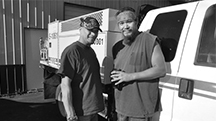
By Brett Larson, October 2, 2015
The night wildland firefighters Richard Shaugobay and Jeremy Boyd arrived in Montana, they went straight to work, digging a trench in the dark to keep the fire from damaging a wooden bridge.
For the second year in a row, Richard and Jeremy spent two weeks fighting forest fires in the western U.S. Last year they were in the Mt. Hood area of Oregon. This year it was the Bob Marshall Wilderness in western Montana, just south of Glacier National Park.
Richard and Jeremy left on Aug. 17 with a 20-man crew of Minnesotans. “They call us ‘flatlanders’ out there,” said Jeremy. He’s the more experienced of the two, having completed his training 12 years ago, and with eight trips under his belt.
After two weeks of living at a ranger station in the wilderness, they returned home Sept. 3 — in better shape, with a few more stories to tell.
DNR Commissioner Susan Klapel is glad they’re back. “All my life I’ve known wildland firefighters, and I am amazed and proud of these guys for what they do,” she said. “I worry constantly until I know they are coming home.”
Last year their friend Cortney Nadeau accompanied them, but this year the Forest Service only requested two firefighters from the Band. All three have completed training in wildland firefighting.
Both Richard and Jeremy enjoyed the experience, even though it involved a long drive, crazy hours and the dangerous unpredictability of wildfires.
For Richard, the scenery made it all worth it. They spent the entire time in the rugged mountains of the Flathead National Forest. “Those are views you don’t see every day,” he said.
“It’s a lot of fun,” added Jeremy. “Like a paid vacation.”
Yeah, if your idea of vacation is lugging a pack through the mountains, digging trenches all day, or running for your life from an out-of-control forest fire.
On a typical day they were up at 6:30 for breakfast, which was cooked by three women who stayed at the ranger station.
They’d make their own lunch from food laid out by the cooks, followed by a briefing session on the status of the fire. Then it was time to hit the fire, where they might spend the whole day “digging lines” — 18-inch trenches through leaves and duff, down to the soil, to try to stop the fire in its tracks.
Other days they might walk gridlines all day: crisscrossing the burned-over areas to make sure the fire was completely out.
By the end of the day, they were beat. “As soon as the boots were off, I’d be asleep,” said Richard.
Their most exciting day was when a back-burn turned and jumped the road. They spent an hour and a half hiking five miles to stay out of harm’s way.
There were definitely some low points. The blisters. Sleeping on the ground without a mattress. And no cell phone reception. “It took a few days to get used to not having a phone,” said Jeremy.
“Like going back in time,” Richard added.
And then there were the packs. A gallon and a half of water weighs 12 pounds. Throw in the hand tools, lunch and a fire shelter that weighs another 12 pounds. If an out-of-control fire comes your way, and you can’t outrun it, you climb in the shelter and let it burn over you. Neither Richard nor Jeremy has had that happen yet, but they’ve heard it sounds like a freight train when the fire burns through.
In spite of the labor and the danger, it was worth it. Both men will be ready to go the next time duty calls.
Richard looks forward to another “vacation” in the mountains. Jeremy, too. “I want to do it until the day I die,” he said.